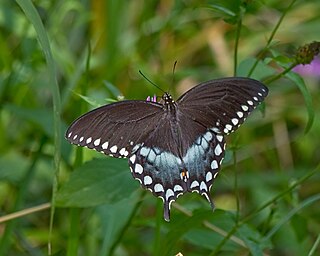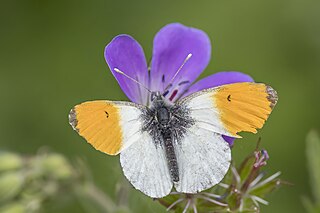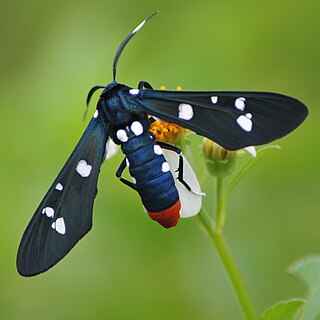
The Pieridae are a large family of butterflies with about 76 genera containing about 1,100 species, mostly from tropical Africa and tropical Asia with some varieties in the more northern regions of North America and Eurasia. Most pierid butterflies are white, yellow, or orange in coloration, often with black spots. The pigments that give the distinct coloring to these butterflies are derived from waste products in the body and are a characteristic of this family. The family was created by William John Swainson in 1820.

Papilio troilus, the spicebush swallowtail or green-clouded butterfly, is a common black swallowtail butterfly found in North America. It has two subspecies, Papilio troilus troilus and Papilio troilus ilioneus, the latter found mainly in the Florida peninsula. The spicebush swallowtail derives its name from its most common host plant, the spicebush, members of the genus Lindera.

Pieris rapae is a small- to medium-sized butterfly species of the whites-and-yellows family Pieridae. It is known in Europe as the small white, in North America as the cabbage white or cabbage butterfly, on several continents as the small cabbage white, and in New Zealand as the white butterfly. The butterfly is recognizable by its white color with small black dots on its wings, and it can be distinguished from P. brassicae by its larger size and the black band at the tip of its forewings.

Papilio zelicaon, the anise swallowtail, is a common swallowtail butterfly of western North America. Both the upper and lower sides of its wings are black, but the upper wing has a broad yellow stripe across it, giving the butterfly an overall yellow appearance. There are striking blue spots on the rear edge of the rear wing, and the characteristic tails of the swallowtails. Its wingspan is 52–80 mm. Its body is somewhat shorter than the rather similar western tiger swallowtail, with which its range overlaps; it also lacks the black stripes, converging toward the tail, of the latter. There is a somewhat darker subspecies, P. z. nitra, which is rare throughout the range, though somewhat more often found at lower elevations.

Pieris brassicae, the large white, also called cabbage butterfly, cabbage white, cabbage moth (erroneously), or in India the large cabbage white, is a butterfly in the family Pieridae. It is a close relative of the small white, Pieris rapae.

Anthocharis cardamines, the orange tip, is a butterfly in the family Pieridae, which contains about 1,100 species. A. cardamines is mainly found throughout Europe and temperate Asia (Palearctic) The males feature wings with a signature orange pigmentation, which is the origin of A. cardamines' common name.

Anthocharis midea, the falcate orangetip, is a North American butterfly that was described in 1809 by Jacob Hübner. It belongs to the family Pieridae, which is the white and sulphurs. These butterflies are mostly seen in the eastern United States, and in Texas and Oklahoma. They eat the nectar of violets and mustards. They tend to live in open, wet woods along waterways, in open swamps, and less often in dry woods and ridgetops. This species is a true springtime butterfly, being on the wing from April to May.
Anthocharis cethura catalina, the Catalina orangetip, is a subspecies of the desert orangetip butterfly that is endemic to Santa Catalina Island, off the California coast of the United States. Very little is known about the subspecies, except that they tend to be found on isolated ridgetops.

Anthocharis sara, the Sara Orangetip is one of three species in the Sara Orangetip complex. It is a California endemic butterfly with populations extending from Baja California into extreme southwest Oregon. The common name, Pacific Orangetip, is obsolete since its implied distribution includes two separate species.

The Pierinae are a large subfamily of pierid butterflies. The subfamily is one of several clades of butterflies often referred to as the whites.

The tribe Anthocharini is one of the subdivisions of the insect order Lepidoptera, which includes the moths and butterflies. It is a further subdivision of the butterfly family Pieridae and subfamily Pierinae; formerly it was considered a subfamily on its own, Anthocharinae. This tribe includes many, but not all, of the orangetip butterflies.

Euchloe ausonides, the large marble or creamy marblewing, is a species of butterfly that occurs in western North America. It lays eggs on the terminal flower buds of a variety of plants in the mustard family, including introduced Eurasian species, and the larvae feed on the buds, flowers and fruit of these plants. In California, it has witnessed population declines since the 1980s, especially in the Central Valley and the Bay Area. In Washington, subspecies the island marble butterfly was listed as an endangered species under the Endangered Species Act in 2020.

Anthocharis is a holarctic genus of the butterfly tribe Anthocharini, in the family Pieridae. These are typically small, white-hued butterflies that have colorful marks just inside the tips of the forewings. The tip colors are usually a red-orange hue, hence the name "orange tip". The larvae of these butterfly often consume cruciferous plants containing chemicals called glucosinolates. This genus is characterized by two of the five subcostal veins branching off before the apex of the cell, by the upper radial being only little united with the subcostal, and by the central discocellular being rather long. In all the species the males have at least the apical portion of the forewing orange red or yellow. Only one species inhabits also the northern districts of the Palearctic region, all the others are found in the south of the Palearctic region, also some species occur in North America, but not one species extends into the tropics. The Anthocharis species have only one brood. The butterflies occur in spring.

Adelpha californica, the California sister, is a species of butterfly in the family Nymphalidae. They are common in California, but can also be found in western Nevada and Oregon, as well as in northern Baja California. The upper surfaces of their wings are dark brown to black with wide cream white bands dissecting both wings and two orange patches near the tips of the forewings. The underside is variously colored with browns, blue, orange, and white. A. californica is unpalatable to predators and is part of a large mimicry complex.

Papilio aegeus, the orchard swallowtail butterfly or large citrus butterfly is a species of butterfly from the family Papilionidae, that is found in eastern Australia and Papua New Guinea.

Ornithoptera paradisea, the paradise birdwing, is a species of birdwing butterfly found in New Guinea.

Syntomeida epilais, the polka-dot wasp moth or oleander moth, is a species of moth thought to be native to the Caribbean. Its larvae feed on the oleander plant. Like most wasp moths, these are day fliers.

Euptoieta claudia, the variegated fritillary, is a North and South American butterfly in the family Nymphalidae. Even though the variegated fritillary has some very different characteristics from the Speyeria fritillaries, it is still closely related to them. Some of the differences are: variegated fritillaries have two or three broods per year vs. one per year in Speyeria; they are nomadic vs. sedentary; and they use a wide range of host plants vs. just violets. And because of their use of passionflowers as a host plant, variegated fritillaries also have taxonomic links to the heliconians. Their flight is low and swift, but even when resting or nectaring, this species is extremely difficult to approach, and, because of this, its genus name was taken from the Greek word euptoietos meaning "easily scared".
Streptanthus breweri is a species of flowering plant in the mustard family known by the common name Brewer's jewelflower. It is endemic to California, where it can be found in the coastal mountain ranges from the Klamath Mountains south to the San Francisco Bay Area. Its habitat includes chaparral and woodlands, usually on serpentine soils. It is an annual herb producing an erect, branching stem up to about 80 centimeters in maximum height. It is hairless except for fine hairs on some of the inflorescence parts, and it may be waxy in texture. The basal leaves have oval blades borne on petioles, and the lance-shaped leaves farther up the stem clasp it at their bases. Flowers occur at intervals along the upper stem, sometimes in a zig-zagging, one-sided array. Each has an urn-shaped calyx of keeled greenish or purplish sepals under a centimeter long. White, purple, or purple-veined white petals emerge from the tip. The fruit is a narrow, curved silique which may be 9 to 11 centimeters in length.



















